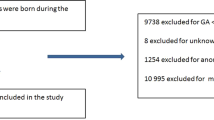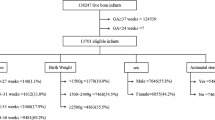Abstract
Objective
The objective of this paper is to compare in-hospital survival and survival without major morbidities in extremely preterm infants in relation to maternal body mass index (BMI).
Methods
This retrospective cohort study included extremely preterm infants (gestational age 220/7–286/7 weeks). This study was conducted at National Institute of Child Health and Human Development Neonatal Research Network sites. Primary outcome was survival without any major morbidity.
Results
Maternal BMI data were available for 2415 infants. Survival without any major morbidity was not different between groups: 30.8% in the underweight/normal, 28.1% in the overweight, and 28.5% in the obese (P = 0.65). However, survival was lower in the obese group (76.5%) compared with overweight group (83.2%) (P = 0.02). Each unit increase in maternal BMI was associated with decreased odds of infant survival (P < 0.01).
Conclusions
Survival without any major morbidity was not associated with maternal obesity. An increase in maternal prepregnancy BMI was associated with decreased odds of infant survival.
This is a preview of subscription content, access via your institution
Access options
Subscribe to this journal
Receive 12 print issues and online access
$259.00 per year
only $21.58 per issue
Buy this article
- Purchase on Springer Link
- Instant access to full article PDF
Prices may be subject to local taxes which are calculated during checkout


Similar content being viewed by others
References
Flegal KM, Kruszon-Moran D, Carroll MD, Fryar CD, Ogden CL. Trends in obesity among adults in the United States, 2005 to 2014. JAMA. 2016;315:2284–91.
Ogden CL, Carroll MD, Curtin LR, McDowell MA, Tabak CJ, Flegal KM. Prevalence of overweight and obesity in the United States, 1999–2004. JAMA. 2006;295:1549–55.
Deputy NP, Dub B, Sharma AJ. Prevalence and trends in prepregnancy normal weight—48 States, New York City, and District of Columbia, 2011–2015. MMWR Morb Mortal Wkly Rep. 2018;66:1402–7.
Cnattingius S, Villamor E, Johansson S, Edstedt Bonamy AK, Persson M, Wikstrom AK, et al. Maternal obesity and risk of preterm delivery. JAMA. 2013;309:2362–70.
Johansson S, Villamor E, Altman M, Bonamy AK, Granath F, Cnattingius S. Maternal overweight and obesity in early pregnancy and risk of infant mortality: a population based cohort study in Sweden. BMJ. 2014;349:g6572.
Nio Health. Classification of overweight and obesity by BMI, waist circumference, and associated disease risks. Bethesda, MD: Nio Health; 2017.
Liu P, Xu L, Wang Y, Zhang Y, Du Y, Sun Y, et al. Association between perinatal outcomes and maternal pre-pregnancy body mass index. Obes Rev. 2016;17:1091–102.
Alexander GR, Himes JH, Kaufman RB, Mor J, Kogan M. A United States national reference for fetal growth. Obstet Gynecol. 1996;87:163–8.
Papile LA, Burstein J, Burstein R, Koffler H. Incidence and evolution of subependymal and intraventricular hemorrhage: a study of infants with birth weights less than 1,500 gm. J Pediatr. 1978;92:529–34.
Walsh MC, Kliegman RM. Necrotizing enterocolitis: treatment based on staging criteria. Pediatr Clin North Am. 1986;33:179–201.
Bell MJ, Ternberg JL, Feigin RD, Keating JP, Marshall R, Barton L, et al. Neonatal necrotizing enterocolitis. Therapeutic decisions based upon clinical staging. Ann Surg. 1978;187:1–7.
Das A, Tyson J, Pedroza C, Schmidt B, Gantz M, Wallace D, et al. Methodological issues in the design and analyses of neonatal research studies: experience of the NICHD Neonatal Research Network. Semin Perinatol. 2016;40:374–84.
Stoll BJ, Hansen NI, Bell EF, Walsh MC, Carlo WA, Shankaran S, et al. Trends in care practices, morbidity, and mortality of extremely preterm neonates, 1993-2012. JAMA. 2015;314:1039–51.
Center for Diseace Control and Prevention. Infant mortality rate by state. Atlanta, Georgia: Center for Diseace Control and Prevention; 2018.
Center for Diseace Control and Prevention. Adult obesity prevalence maps. Behavioral risk factor surveillance system. Atlanta, Georgia: Center for Diseace Control and Prevention; 2018.
Carmichael SL, Kan P, Gould JB, Stevenson DK, Shaw GM, Lee HC. Maternal prepregnancy body mass index and risk of bronchopulmonary dysplasia. Pediatr Res. 2017;82:8–13.
Pai VV, Carmichael SL, Kan P, Leonard SA, Lee HC. Maternal body mass index and risk of intraventricular hemorrhage in preterm infants. Pediatr Res. 2018;83:1146–51.
Higgins L, Mills TA, Greenwood SL, Cowley EJ, Sibley CP, Jones RL. Maternal obesity and its effect on placental cell turnover. J Matern Fetal Neonatal Med. 2013;26:783–8.
Hayes EK, Lechowicz A, Petrik JJ, Storozhuk Y, Paez-Parent S, Dai Q, et al. Adverse fetal and neonatal outcomes associated with a life-long high fat diet: role of altered development of the placental vasculature. PLoS ONE. 2012;7:e33370.
De Souza CT, Araujo EP, Bordin S, Ashimine R, Zollner RL, Boschero AC, et al. Consumption of a fat-rich diet activates a proinflammatory response and induces insulin resistance in the hypothalamus. Endocrinology. 2005;146:4192–9.
Freeman LR, Zhang L, Nair A, Dasuri K, Francis J, Fernandez-Kim SO, et al. Obesity increases cerebrocortical reactive oxygen species and impairs brain function. Free Radic Biol Med. 2013;56:226–33.
Buckman LB, Hasty AH, Flaherty DK, Buckman CT, Thompson MM, Matlock BK, et al. Obesity induced by a high-fat diet is associated with increased immune cell entry into the central nervous system. Brain Behav Immun. 2014;35:33–42.
van der Burg JW, Allred EN, Kuban K, O’Shea TM, Dammann O, Leviton A. Maternal obesity and development of the preterm newborn at 2 years. Acta Paediatr. 2015;104:900–3.
Thaler JP, Yi CX, Schur EA, Guyenet SJ, Hwang BH, Dietrich MO, et al. Obesity is associated with hypothalamic injury in rodents and humans. J Clin Invest. 2012;122:153–62.
Rivera HM, Christiansen KJ, Sullivan EL. The role of maternal obesity in the risk of neuropsychiatric disorders. Front Neurosci. 2015;9:194.
Sewell MF, Huston-Presley L, Amini SB, Catalano PM. Body mass index: a true indicator of body fat in obese gravidas. J Reprod Med. 2007;52:907–11.
Lindsay CA, Huston L, Amini SB, Catalano PM. Longitudinal changes in the relationship between body mass index and percent body fat in pregnancy. Obstet Gynecol. 1997;89:377–82.
Callaway LK, Prins JB, Chang AM, McIntyre HD. The prevalence and impact of overweight and obesity in an Australian obstetric population. Med J Aust. 2006;184:56–9.
Mamun AA, Lawlor DA, O’Callaghan MJ, Williams GM, Najman JM. Family and early life factors associated with changes in overweight status between ages 5 and 14 years: findings from the Mater University Study of Pregnancy and its outcomes. Int J Obes. 2005;29:475–82.
Claesson IM, Josefsson A, Sydsjo G. Weight six years after childbirth: a follow-up of obese women in a weight-gain restriction programmme. Midwifery. 2014;30:506–11.
Claesson IM, Josefsson A, Olhager E, Oldin C, Sydsjo G. Effects of a gestational weight gain restriction program for obese women: sibling pairs’ weight development during the first five years of life. Sex Reprod Health. 2018;17:65–74.
Funding
Supported by grants from the Eunice Kennedy Shriver National Institute of Child Health and Human Development, National Institutes of Health, Bethesda, Maryland, USA (UG1HD27904, UG1HD21364, U10HD68284, UG1HD27853, UL1TR77, UG1HD40492, UL1TR1117, UL1TR1111, UG1HD27851, UL1TR454, U10HD27856, UL1TR6, UG1HD87229, U10HD68278, U10 HD36790, UG1HD27880, UL1TR93, UG1 HD34216, U10HD68270, UG1HD53109, M01RR59, UL1TR442, UG1HD53089, UL1TR41, UG1HD68244, UG1HD68263, UL1TR42, UG1HD40689, UG1HD87226, UL1TR105, and U10HD21385).
Author information
Authors and Affiliations
Consortia
Contributions
SC: developed the protocol, created data collection form, reviewed analysis, and drafted first version of the paper. ARL: contributed to the conception and design, reviewed the protocol, contributed to the analysis, and revised the paper critically. EAS: reviewed the protocol, conducted the data analysis, and revised the paper critically. ST: reviewed the protocol, conducted the data analysis, and revised the paper critically. GN: contributed to the conception and design, reviewed the protocol, contributed to the analysis, and revised the paper critically. MHW: contributed to the conception and design, reviewed the protocol, contributed to the analysis, and revised the paper critically. NA: contributed to the conception and design, reviewed the protocol, contributed to the analysis, and revised the paper critically. EFB: contributed to the conception and design, reviewed the protocol, contributed to the analysis, and revised the paper critically. KPVM: contributed to the conception and design, reviewed the protocol, contributed to the analysis, and revised the paper critically. DKS: contributed to the conception and design, reviewed the protocol, contributed to the analysis, and revised the paper critically. EFW: contributed to the conception and design, reviewed the protocol, contributed to the analysis, and revised the paper critically. RGG: contributed to the conception and design, reviewed the protocol, contributed to the analysis, and revised the paper critically. AD: contributed to the conception and design, supervised the analysis, reviewed the protocol, and revised the paper critically. SS: contributed to the conception and design, reviewed the protocol, contributed to the analysis, and revised the paper critically. All authors approved the final paper as submitted and agree to be accountable for all aspects of the work.
Corresponding author
Ethics declarations
Conflict of interest
The authors declare that they have no conflict of interest.
Additional information
Publisher’s note Springer Nature remains neutral with regard to jurisdictional claims in published maps and institutional affiliations.
Members of the Eunice Kennedy Shriver National Institute of Child Health and Human Development (NICHD) Neonatal Research Network are listed in Supplementary information.
Supplementary information
Rights and permissions
About this article
Cite this article
Chawla, S., Laptook, A.R., Smith, E.A. et al. In-hospital mortality and morbidity among extremely preterm infants in relation to maternal body mass index. J Perinatol 41, 1014–1024 (2021). https://doi.org/10.1038/s41372-020-00847-0
Received:
Revised:
Accepted:
Published:
Issue Date:
DOI: https://doi.org/10.1038/s41372-020-00847-0
This article is cited by
-
Association of maternal pre-pregnancy or first trimester body mass index with neurodevelopmental impairment or death in extremely low gestational age neonates
Journal of Perinatology (2024)
-
The association of maternal overweight on long-term neurodevelopmental outcomes in premature infants (< 29 weeks) at 18–24 months corrected age
Journal of Perinatology (2023)



